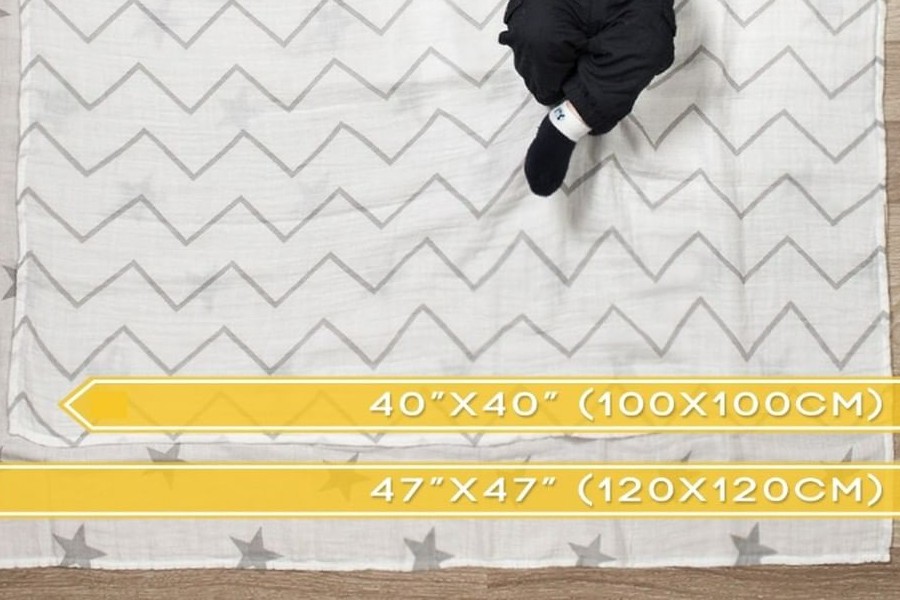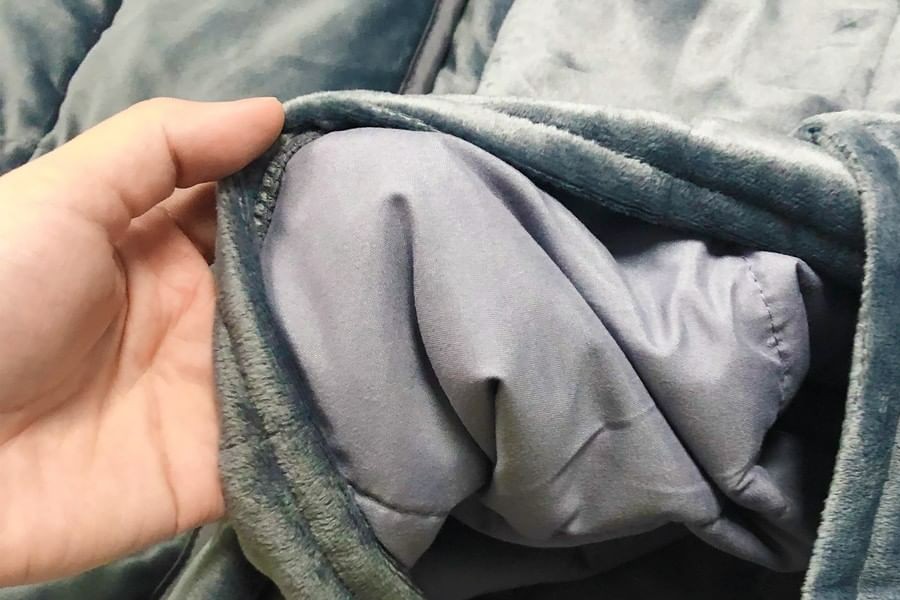There are a few reasons why it is important to choose the right weight for a weighted blanket. If the blanket is too light, it will not provide the necessary pressure to help ease anxiety or improve sleep. If the blanket is too heavy, it could actually make anxiety worse or make it difficult to move around during the night.
The ideal weight for a weighted blanket is typically 10% of a person’s body weight.
For example, if an elderly person weighs 120 pounds, you should choose a weighted blanket for the seniors that weighs 12 pounds.
If you are wondering: “How heavy should my weighted blanket be?” – this article is for you.
In general, the optimal weight of a weighted blanket is usually 10-15% of a person’s body weight.
What Is a Weighted Blanket?

A weighted blanket is a type of therapeutic blanket that uses deep pressure stimulation to provide a calming and relaxing effect. The blanket is usually filled with small beads or pellets that help to distribute the weight evenly.
The weight of the blanket can vary depending on the size and weight of the person using it.
What is a Weighted Blanket Made of?
A weighted blanket is usually made of a cotton or flannel outer fabric, with a fill of microfiber beads, sand, steel beads, pebbles, or grains. The weight of the blanket is distributed evenly across the surface, providing a gentle, comforting pressure that can help people relax.
Who Can Use A Weighted Blanket?
Weighted blankets are often used by people with autism, anxiety, or sensory processing disorders. They can also be helpful for people with insomnia or who have trouble sleeping.
Weighted Blanket Weight Chart
The recommended weights for a weighted blanket can vary depending on the person and can be anywhere from 5% to 12% of a person’s body weight. But it is preferable to choose a weighted blanket that weighs approximately 10% of a person’s body weight.
Below is a table that includes the ratio of the body weight range to the weight range of the weighted blanket.
| Body Weight Range | Weighted Blanket Weight Range |
|---|---|
| 25-60 pounds | 2-6 pounds |
| 35-84 pounds | 3-8 pounds |
| 50-120 pounds | 5-12 pounds |
| 60-144 pounds | 6-14 pounds |
| 75-180 pounds | 7-18 pounds |
| 85-194 pounds | 8-19 pounds |
| 100-240 pounds | 10-24 pounds |
| 110-264 pounds | 11-26 pounds |
| 125-300 pounds | 12-30 pounds |
| 150-360 pounds | 15-36 pounds |
How Heavy Should a Weighted Blanket Be for Adults?
The ideal weight for a weighted blanket for adults is between 12 and 20 pounds. This weight range ensures that the blanket creates a hugging feeling on your body, which can help to reduce stress and promote calmness.
Additionally, a heavier blanket is more likely to help you fall asleep more easily and stay asleep for longer periods of time.
Weighted Blanket Weights for Children

Weighted blankets are becoming increasingly popular with children and parents alike. These blankets typically weigh between 3 and 12 pounds and can help provide a sense of comfort and security for children.
Some of the benefits of weighted blankets for children include improved sleep, reduced anxiety, and decreased sensory processing difficulties.
Although weighted blankets have not been proven to definitively help with all medical conditions, they can be a helpful tool for many children.
How to Tell if a Weighted Blanket is Too Heavy?
- There are a few key things to look for when trying to determine if a weighted blanket is too heavy.
- First, you should feel like you can move underneath the blanket and not feel suffocated or trapped.
- Second, you should be able to breathe easily while using the blanket.
- Third, you should be able to sleep comfortably in it.
- Lastly, if you feel like the pressure from the blanket is too much, it is likely too heavy.
How to Choose a Weighted Blanket?
Factors to consider when choosing a weighted blanket include the size and weight of the blanket, material, and filling.
Size
The 10 percent rule and the chin-to-toe rule are the two most important criteria to consider when choosing the size of a weighted blanket.
The 10 percent rule states that the weight of the blanket should be 10 percent of the body weight of the person using it. So, if a person weighs 150 pounds, the blanket should weigh 15 pounds.
The chin-to-toe rule states that the blanket should be long enough to reach from the chin to the feet, and the width should be wide enough to comfortably cover the person under it.

For children, the length of the blanket should not exceed 44 inches. For adults, quilt size depends on preference or need.
Most manufacturers and retailers list size charts on the package or product website. For children, the width is most often given as 30 to 38 inches and for adults as 36 to 40 inches.
For example, the width of a mattress for a double bed is 40 inches.
When it comes to length, most manufacturers specify the length of children’s blankets as 42 to 60 inches and adults as 50 to 80 inches.
But it is also worth considering special preferences: different people with different needs will choose blankets of different lengths.
How much should my weighted blanket weigh
First, you need to decide what you need a weighted blanket for. If you are looking for a blanket for sleeping, we recommend choosing a weight that is 8-10% of your body weight. If you are looking for a blanket to help with anxiety or stress, you can choose a weight that is up to 15% of your body weight.
The table gives approximate blanket weights that will be convenient for the weight range indicated.
| Body Weight Range | Weighted Blanket |
|---|---|
| Less Than 25kg | 2.2kg Kids Blanket |
| 25kg to 55kg | 4.5kg Blanket |
| 55kg to 80kg | 6.8kg Blanket |
| 80kg + | 9.0kg Blanket |
It is also very important to consider the wishes of the person for whom you are purchasing blankets. If he or she is uncomfortable under heavy objects, consider a lighter blanket.
Once you have decided on the size and weight of the blanket, the next step is to choose the material. Weighted blankets can be made from a variety of materials, so it is important to choose one that is comfortable for you.
Material
There are many factors to consider when choosing the right material for a weighted blanket.

The first is the climate. If you live in a warm climate, you will want to choose a lightweight, breathable material. If you live in a cold climate, you will want to choose a heavier, warmer material.
The second factor is the person’s sleep habits. If the person is a light sleeper, you will want to choose a material that is not too loud or crinkly. If the person is a heavy sleeper, you will want to choose a material that is more durable.
The third factor is the person’s allergies. If the person has allergies, you will want to choose a material that is hypoallergenic.
The fourth factor is the person’s age. If the person is a child, you will want to choose a material that is soft and safe. If the person is an adult, you will want to choose a material that is more durable.
There are a few popular materials used in weighted blankets.
One is cotton. Cotton is a popular choice because it is soft, durable, and easy to care for. It is also a natural material that is hypoallergenic, making it a good choice for people with allergies.
Another popular material is polyester. Polyester is a synthetic material that is also soft, durable, and easy to care for. It is less expensive than cotton and has a bit more give, making it a good choice for people who want a softer blanket.
What’s in a weighted blanket

There are a variety of materials that can be used to fill a weighted blanket, but the most popular fillings are plastic poly pellets and glass beads.
The pellets look like small pebbles, and one huge plus side to them is that they’re usually machine washable.
The beads are typically smaller, but they can offer a more even distribution of weight.
How to Choose a Weighted Blanket for Couples?
Weighted blankets can be a great addition for couples looking for a way to get better sleep. When choosing a weighted blanket for couples, it is important to keep in mind the different weights and sizes that are available.
Couples should also consider their personal preferences when it comes to blanket weight and size.
Ultimately, the decision of which weighted blanket is best for a couple should be based on what will provide the most comfort and support for both people.
Weighted Blanket Safety
Weighted blankets are not recommended for people with certain medical conditions, as they may pose a health risk. People with low blood pressure, breathing problems, type 2 diabetes, or obstructive sleep apnea should consult a physician before using a weighted blanket. Even for people without these conditions, a weighted blanket may be too tight and cause feelings of claustrophobia.
If you are unsure of the risks to your health, consult a physician before purchasing a weighted blanket.
FAQ
What percentage of body weight should a weighted blanket be?
A general guideline is that a weighted blanket should be around 10% of the person’s body weight, but this can vary depending on the individual.
What is a weight of a weighted blanket for a 10-year-old?
The weight of a weighted blanket for a 10-year-old child should be about 10% of the child’s body weight plus 1-2 pounds. This will help your child stay safe and get the most benefit from the blanket.
What is the weight ratio for a weighted blanket?
The weight ratio for a weighted blanket is 10:1. This means that for every 10 pounds of body weight, the blanket should weigh 1 pound.
How do I calculate the weight for a weighted blanket?
First, take 10 percent of a person’s body weight. Then, in many cases, it is recommended to add a few more pounds over and above 10 percent.
Also, manufacturers and many retailers have a weight table that makes it easy to choose the right weight when ordering a weighted blanket.
Also read:
Conclusion
The difficulty of choosing the weight of a weighted blanket may vary depending on the person. Some factors that may affect the decision are the individual’s weight, desired level of comfort, and whether the person gets hot or cold easily.
But we really hope that our article has made your choice of a weighted blanket at least a little easier.
If you still have questions, leave them below in the comments.
References
- Weighted blanket – https://en.wikipedia.org/wiki/Weighted_blanket
- Size (length, area, and volume) – https://www.britannica.com/science/length-area-and-volume
- Health risk (Top 10 DIY Safety Tips) – https://home.howstuffworks.com/home-improvement/home-diy/projects/10-diy-safety-tips.htm?srch_tag=wjn66r2rlotdqaxjbrn35x2qw6ez5afl






